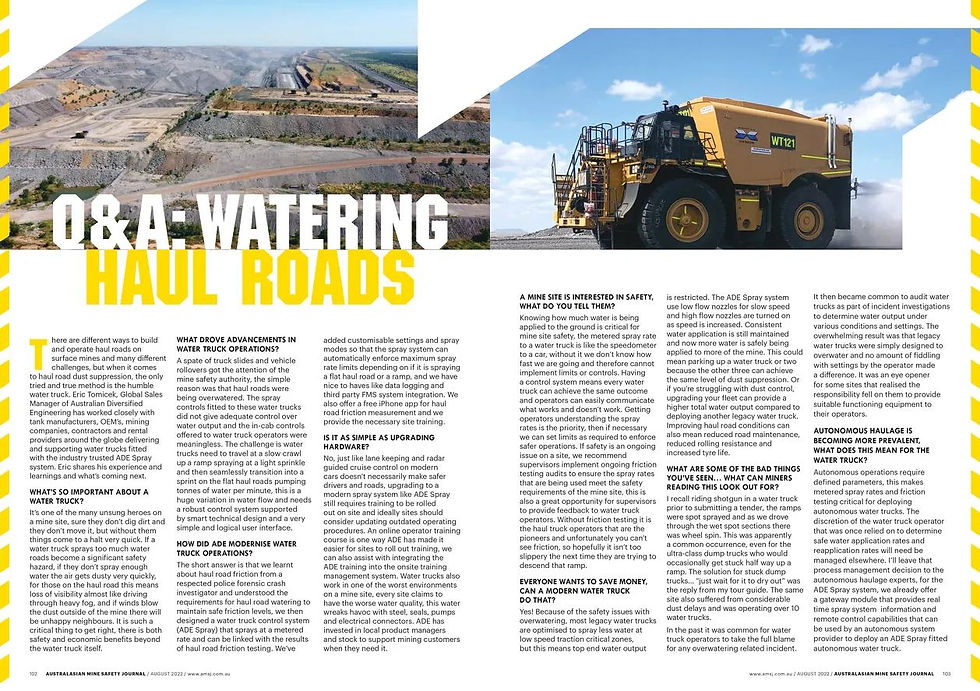When is a wet haul road too slippery? Are we making consistent decisions?
- ADE

- Feb 14, 2022
- 4 min read
Updated: Oct 21, 2022
When rain falls over an open cut mining operation, the question will eventually be asked; are the haul roads too slippery and can we continue to safely operate our fleet? Supervisors and Open Cut Examiners are then called to make an assessment on the haul road conditions and make the final decision to continue or stop production. But what factors are being taken into consideration when making these assessments and are the decisions consistent?

The most common method of assessing a wet haul road is to simply drive the haul road and use our inbuilt ‘ass-o-meter’ to feel the grip between the vehicle and haul road surface and monitor feedback through acceleration, braking and steering inputs. Unfortunately, not all ‘ass-o-meters’ are calibrated equally and where one person might feel conditions are unsafe, another might instruct haul road operations to continue as per normal.
Halting operations too early can lead to significant lost revenue, holding on too long can result in dangerous conditions and a costly accident. Developing a method that can result in a consistent decision making process will improve open cut mining operations.
To make consistent decisions we need to be using the same indicators, in the case of wet haul roads this means measuring the coefficient of friction. The mine haul road friction measurement protocol was developed in Australia by former Police forensic crash investigators. The goal was to create a simple low cost and repeatable method of measuring haul road friction.

A free iPhone app developed by Australian Diversified Engineering (ADE) is available, search for ‘Friction Plus by ADE’ in the Apple app store or alternatively the Vericom friction test tool is an industry trusted device and can also be purchased through ADE. The measurement instruments are mounted into standard light vehicles such as a dual cab ute or wagon, and the supervisor performs a series of quick braking tests to determine the coefficient of friction.
Now, when it starts to rain on a mine site, supervisors can quickly perform friction tests on high risk haul roads and quickly determine operational risks in a consistent fashion.
Wet weather is not the only risk that benefits from haul road friction measurement, water truck operations and in particular water trucks that spray at a metered water application rate such as the ADE Spray system can benefit greatly from measuring haul road friction. Mine sites can measure friction after different watering rates to determine the friction profile of the haul road. Supervisors will then be able to provide guidance on optimal water application rates to water truck operators, improving efficiency of water truck and dust suppression operations, and reducing the risk of over watering and a potential slide or vehicle roll over.

Water trucks are intended to reduce the risk of dust, but by applying water to the haul roads the risk of over watering is now added to the list of operational hazards. Sometimes speed, operator fatigue or distraction can result in a truck exceeding a haul roads available friction, and once exceeded it can be extremely difficult to regain control on haul roads with very low friction.
In the near future when autonomous water trucks join our autonomous haul fleets, water trucks will need a baseline water application rate to be programmed into the water truck spray control system to ensure haul roads are not over watered. Friction measurement will play a critical role ensuring autonomous fleet managers select water application rates that are suitable for each haul road section which will lead to a more efficient autonomous haul fleet.
It is important to measure friction along different haul roads around the mine as the friction levels will vary due to topography and the different haul road materials that can make up a mine haul road. A one size fits all approach to water application rates will not be sufficient or even efficient. Otherwise spray rates will need to be set at the lowest friction measured haul roads and this will compromise haul road dust suppression as haul roads will require more frequent watering.

Another important use for haul road friction measurement is for haul road maintenance operations such as grading or sheeting. When sheeting a haul road, a mine site can measure and record friction values before, after and over time to determine the performance and longevity of the new haul road sheeting and compare different haul road sheeting materials. The same principles apply to haul road maintenance and determining when a haul road needs to be graded to improve drainage and friction performance. Mine sites have also used friction measurement to test different grader blades and grading methods, one mine site found that by changing grader blades and grading after rain events, the time required for friction levels to recover to acceptable levels shortened significantly.
ADE can provide measuring devices and on site training sessions for supervisors on the importance of haul road friction, how to measure it and how the results of friction measurement can improve the robustness of the decision making process
Read More: www.amsj.com.au
Australasian Mine Safety Journal: November 2021 Edition





Comments